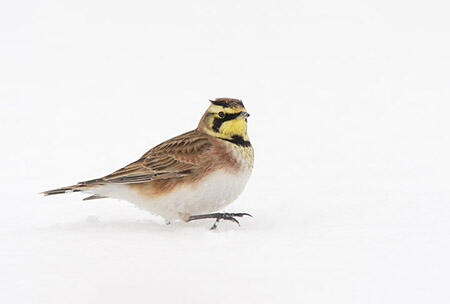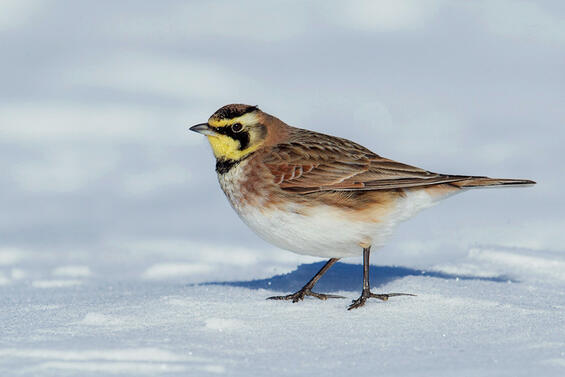- Scientific name: Eremophila alpestris
Species of Greatest Conservation Need (MA State Wildlife Action Plan)
Description

Horned lark
The horned lark is a medium-sized (16-20 cm [6.3-7.9 in]) songbird of large open areas with sparse vegetation, particularly coastal dunes, airfields and agricultural fields. They are somewhat drab in plumage, mostly shades of brown, but have distinctive horns (occipital feather tufts), a strong black bar across the throat, and a wash of yellow on the face and throat. Their twinkling metallic song is typically heard given in flight as the male circles above the breeding territory. In non-breeding situations, they can form large flocks that roam grasslands and dunes.
Life cycle and behavior
Horned larks breed in large, open, dry areas with patches of bare ground, such as dunes and airfields and fallow agricultural fields. The nest is simply a shallow scrape on the bare ground where 2-5 eggs are laid. The female will incubate the eggs for 11-12 days, and chicks will remain in the nest for 8-12 days. Horned larks forage in small groups for insects and seeds during the breeding season but will form large roving flocks (100s of individuals) associated with large, open, and often barren landscapes.
Population status
Horned lark breeding bird survey data is not available for Massachusetts, but across North America there was an annual decline of 2.38 percent from 1966-2013.
Distribution and abundance
Massachusetts Breeding Bird Atlas 1 (1974-1979) surveys found that horned larks were making a living at scattered locations inland, but their stringent habitat requirements meant that they were mostly coastal in distribution. The Marble Valleys had 10% horned lark occupancy, likely in areas of abandoned or fallow farmland. The Connecticut River Valley apparently had suitable breeding locations in 14% of the region, both in farm fields and at airports kept free of dense vegetation. Only a small scattering of occupied blocks bridged the gap from the Connecticut River Valley to the coast. The Coastal Plains had breeding horned larks on the beaches of Essex and Plymouth Counties, and the Bristol/Narragansett Lowlands reported several instances of inland breeding as well as nests found around the shores of Buzzards Bay. More than 60% of the species’ statewide distribution fell in Cape Cod and the Islands, where sandy dune habitat was readily available for horned larks looking to settle down.
Within the three decades between Atlas 1 and Atlas 2 (2007-2011), the horned lark began to opt out of Massachusetts as a breeding species. Distribution patterns in Atlas 2 weakly mirror those of Atlas I: up the Connecticut River, sparsely spread eastward, with the species’ most notable breeding strongholds in the southeastern Coastal Plains and on Cape Cod and the Islands. Horned larks completely retreated from the far west and almost completely retreated from the Bristol/Narragansett Lowlands. The birds posted only a symbolic guard in Essex County, and even in their stronghold on Cape Cod and the Islands they disappeared from a dozen of the most well-surveyed blocks.
Habitat
Horned larks in Massachusetts are associated with large, open, and often barren habitats. Breeding habitat is now primarily limited to large coastal dune systems dominated by bare sand and sparse dune grass (Ammophila sp.). Sandplain grassland is a secondary breeding habitat, though aside from a few large airfields, this habitat has practically been lost from the state. Large fallow fields used for row crops, particularly in the Connecticut River Valley, occasionally support breeding horned larks.
Flocks of horned larks form in winter, sometimes numbering in the 100s, and utilize large patches of open, sparsely vegetated habitat similar to breeding habitat, though patches may be smaller. Harvested cornfields and mowed hayfields are important winter and migratory habitats in interior Massachusetts.
Healthy habitats are vital for supporting native wildlife and plants. Explore habitats and learn about conservation and restoration in Massachusetts.

Horned lark
Threats
The population decline and retraction of range for horned larks in Massachusetts can be directly attributed to habitat loss, specifically the loss of expansive open areas either to development or succession. Conflicting mowing practices at airfields may result in reduced breeding success at airfields, as can the tilling/seeding of large agricultural fields during the breeding season.
Predation by domestic cats has been identified as the largest source of mortality for wild birds in the United States with the number of estimated mortalities exceeding 2 billion annually. Cats are especially a threat to those species that nest on or near the ground.
An additional threat to the species is collisions with buildings and other structures, as approximately 1 billion birds in the United States are estimated to die annually from building collisions. A high percentage of these collisions occur during the migratory periods when birds fly long distances between their wintering and breeding grounds. Light pollution exacerbates this threat for nocturnal migrants as it can disrupt their navigational capabilities and lure them into urban areas, increasing the risk of collisions or exhaustion from circling lit structures or areas.
Conservation
Habitat loss is the primary limiting factor of horned lark distribution in Massachusetts: protecting large tracts of suitable habitat and managing existing habitats at a very early stage of succession is a key conservation action.
Timing mowing and agricultural activities at airfields and on farmlands to be compatible with breeding attempts by horned larks is important.
Promote responsible pet ownership that supports wildlife and pet health by keeping cats indoors and encouraging others to follow guidelines found at fishwildlife.org.
Bird collision mortalities can be minimized by making glass more visible to birds. This includes using bird-safe glass in new construction and retrofitting existing glass (e.g., screens, window decals) to make it bird-friendly and reducing artificial lighting around buildings (e.g., Lights Out Programs, utilizing down shielding lights) that attract birds during their nocturnal migration.
References
Beason, R.C. 1995. Horned lark (Eremophila alpestris), The Birds of North America Online (A. Poole, Ed.). Ithaca: Cornell Lab of Ornithology; Retrieved from the Birds of North America Online: http://bna.birds.cornell.edu/bna/species/195
Breeding Bird Atlas Explorer (online resource). 2015. U.S. Geological Survey Patuxent Wildlife Research Center. <2015-02-15>. http://www.pwrc.usgs.gov/bba. Data compiled from: Massachusetts Breeding Bird Atlas 2007-2011
Sauer, J.R., J.E. Hines, J.E. Fallon, K.L. Pardieck, D.J. Ziolkowski, Jr., and W.A. Link. 2014. The North American Breeding Bird Survey, Results and Analysis 1966 - 2013. Version 01.30.2015 USGS Patuxent Wildlife Research Center, Laurel, MD
Veit, R.R., and W.R. Petersen. 1993. Birds of Massachusetts. Massachusetts Audubon Society, Lincoln MA.
Contact
| Date published: | April 4, 2025 |
|---|